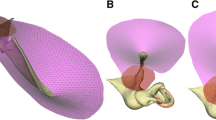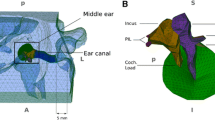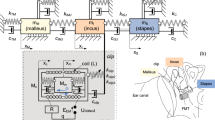Abstract
A lumped parametric model of the human auditoria peripherals consisting of six masses suspended with six springs and ten dashpots was proposed. This model will provide the quantitative basis for the construction of a physical model of the human middle ear. The lumped model parameters were first identified using published anatomical data, and then determined through a parameter optimization process. The transfer function of the middle ear obtained from human temporal bone experiments with laser Doppler interferometers was used for creating the target function during the optimization process. It was found that, among 14 spring and dashpot parameters, there were five parameters which had pronounced effects on the dynamic behaviors of the model. The detailed discussion on the sensitivity of those parameters was provided with appropriate applications for sound transmission in the ear. We expect that the methods for characterizing the lumped model of the human ear and the model parameters will be useful for theoretical modeling of the ear function and construction of the ear physical model.








Similar content being viewed by others
References
Aibara R, Welsh JT, Puria S, Goode RL (2001) Human middle ear sound transfer function and cochlear input impedance. Hear Res 152:100–109
von Békésy G (1960) Experiments in hearing. McGraw-Hill, New York
Davis H (1978) Anatomy and physiology of the auditory system. In: Davis H, Silverman SR (eds) Hearing and deafness, 3rd edn. Holt, Rinehart & Winston, New York
Fletcher R (1980) Practical methods of optimization. Vol 1, unconstrained optimization and vol 2, constrained optimization, vol. 2. Wiley, New York
Gan RZ, Sun Q, Dyer RK, Chang KH, Dormer KJ (2002) Three-dimensional modeling of middle ear biomechanics and its applications. Otol Neurotol 23:271–280
Gan RZ, Wood MW, Dormer KJ (2004) Human middle ear transfer function measured by double laser interferometry system. Otol Neurotol 25(4):423–435
Goode RL, Killian M, Nakamura K, Nishihara S (1994) New knowledge about the function of the human middle ear: development of an improved analog model. Am J Otol 15:145–154
Håkansson B, Carlsson P (1989) Skull simulator for direct bone conduction hearing devices. Scand Audiol 18:91–98
Hudde H, Weistenhöfer C (2000) Circuit model of middle ear function. In: Rosowski JJ, Merchant SN (eds) The function and mechanics of normal, diseased and reconstructed middle ears. Kugler Publications, The Hague, The Netherlands
Kelly DJ, Prendergast PJ, Blayney AW (2003) The effect of prosthesis design on vibration of the reconstructed ossicular chain: a comparative finite element analysis of four prostheses. Otol Neurotol 24:11–19
Kirikae I (1960) The structure and function of the middle ear. Tokyo University Press, Tokyo
Kringlebotn M (1988) Network model for the human middle ear. Scan Audiol 17:75–85
Lutman ME, Martin AM (1979) Development of an electroacoustic analogue model of the middle ear and acoustic reflex. J Sound Vibration 64:133–157
Meister H, Walger M, Mickenhagen A, von Wedel H, Stennert E (1999) Standardized measurements of the sound transmission of middle ear implants using a mechanical middle ear model. Eur Arch Otorhinolaryngol 256:122–127
Møller AR (1961) Network model of the middle ear. J Acoust Soc Am 33:168–176
Rosowski JJ, Merchant SN (1995) Mechanical and acoustic analysis of middle ear reconstruction. Am J Otol 16:486–497
Stinson MR (1989) Specification of the geometry of the human ear canal for the prediction of sound-pressure level distribution. J Acoust Soc Am 85:2492–2503
Taschke H, Weistenhöfer C, Hudde H (2000) A full-sized physical model of the human middle ear. Acoustica 86:103–116
Wever EG, Lawrence M (1954) Physiological acoustic. Princeton University Press, Princeton, New Jersey
Zwislocki JJ (1962) Analysis of the middle ear function. Part I: input impedance. J Acoust Soc Am 34:1514–1523
Acknowledgement
This work was supported by the Oklahoma Center for the Advancement of Science and Technology, Grant HR01-045.
Author information
Authors and Affiliations
Corresponding author
Additional information
Supported by Oklahoma Center for the Advancement of Science and Technology.
Rights and permissions
About this article
Cite this article
Feng, B., Gan, R.Z. Lumped parametric model of the human ear for sound transmission. Biomech Model Mechanobiol 3, 33–47 (2004). https://doi.org/10.1007/s10237-004-0044-9
Received:
Accepted:
Published:
Issue Date:
DOI: https://doi.org/10.1007/s10237-004-0044-9




